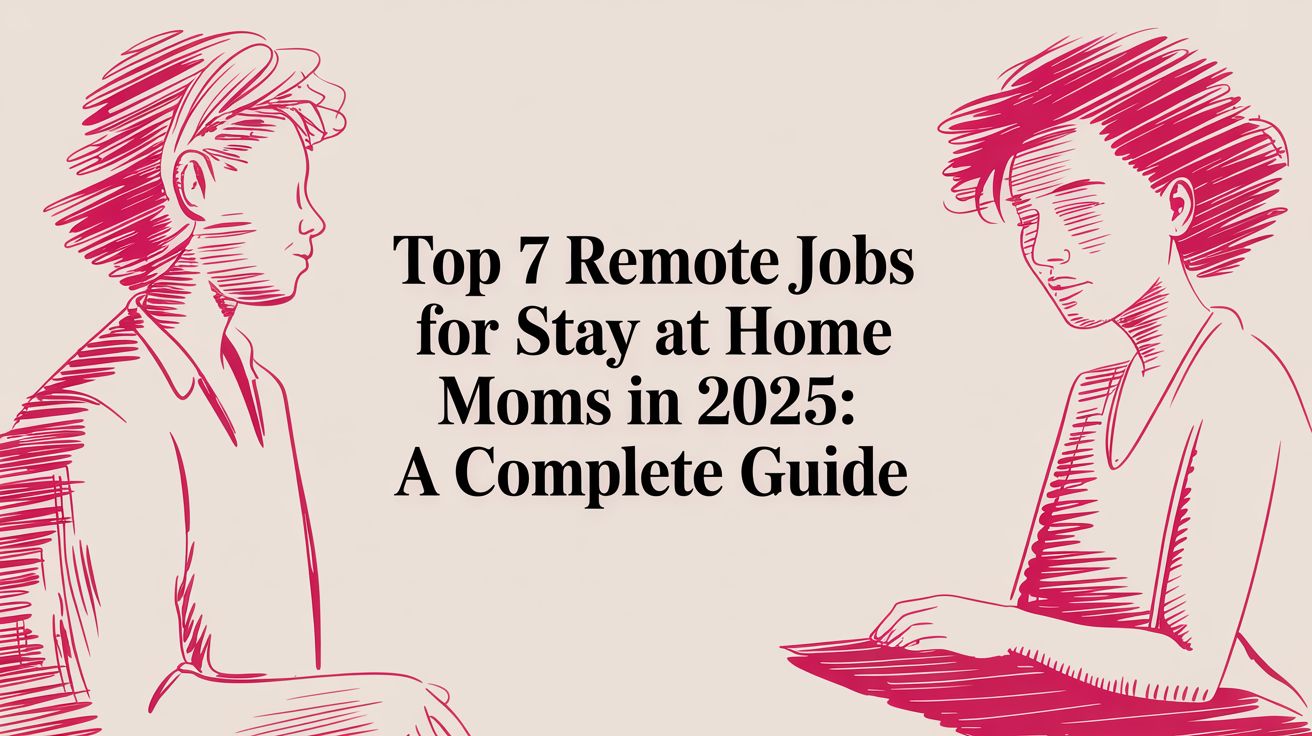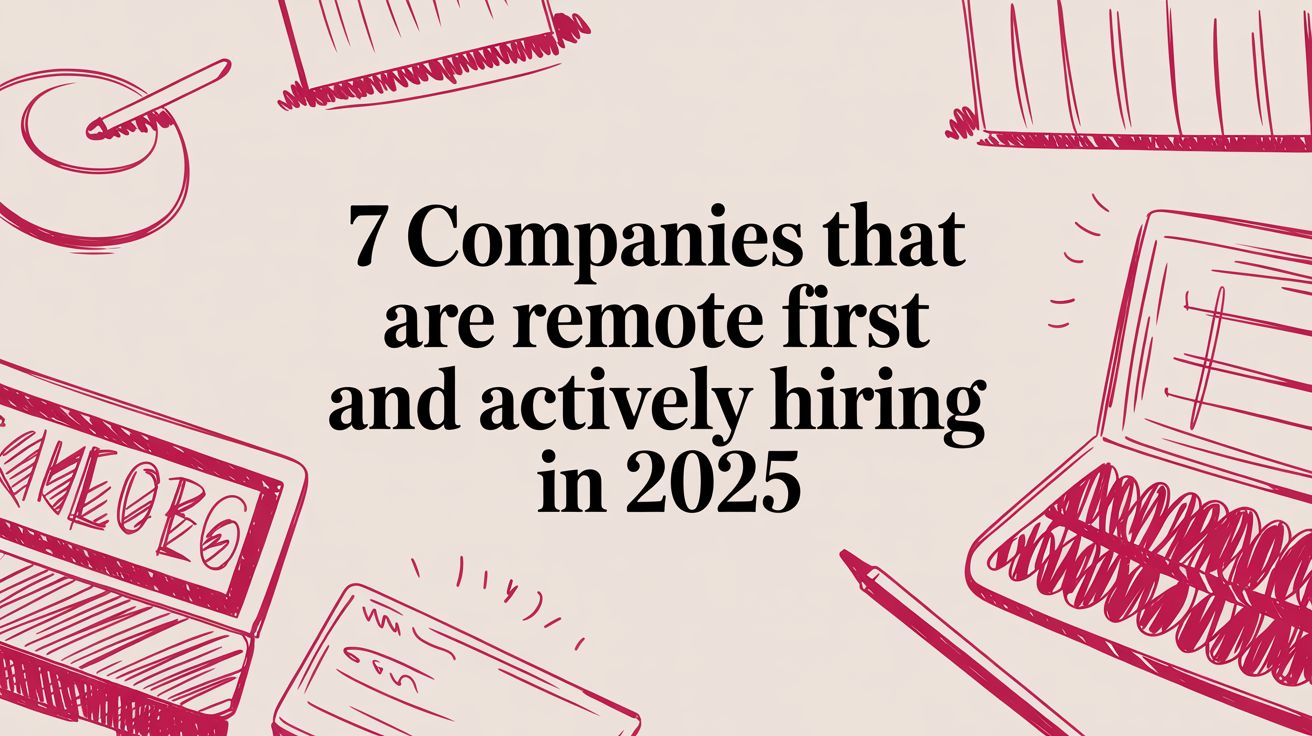Remote Hiring: talent sourcing strategies for 2025
Max
In the new era of work, finding exceptional remote talent is no longer a luxury—it’s a competitive necessity. As companies embrace a remote-first mindset, the talent pool has exploded from a local pond to a global ocean. However, this vastness brings new challenges: how do you find the right people amidst the noise and across different time zones? Standard recruiting methods often fall short when faced with this scale.
Success now hinges on sophisticated, proactive, and targeted talent sourcing strategies. A reactive “post-and-pray” approach is inefficient. Instead, modern recruiters must actively seek, engage, and nurture relationships with top candidates wherever they are located. This requires a multi-channel approach that combines technology, networking, and strategic outreach. For deeper insights into effectively recruiting talent across geographical boundaries, consider strategies for mastering virtual hiring for remote employees.
This guide breaks down 10 proven methods to elevate your remote hiring game. We move beyond generic advice to provide actionable frameworks, specific implementation tips, and real-world examples tailored for the modern work landscape. Whether you are scaling a startup or optimizing a global enterprise, these strategies will equip you with the tools to build a world-class distributed team by proactively sourcing the best talent available, rather than waiting for them to find you. You will learn how to leverage everything from employee referrals and social media to advanced skills-based sourcing and passive candidate outreach to secure a competitive edge.
1. Employee Referral Programs
Employee referral programs are a cornerstone of modern talent sourcing strategies, transforming your existing team into a powerful recruitment engine. This structured approach encourages current employees to recommend qualified candidates from their professional networks. By leveraging internal advocates, companies tap into a pre-vetted talent pool, often leading to hires who are a better cultural fit and have a higher retention rate.
This strategy capitalizes on the principle of social proof; a recommendation from a trusted colleague carries more weight than a standard job posting. It’s an efficient way to find passive candidates who aren’t actively looking but are open to the right opportunity. Companies like Google have famously refined this model, offering significant financial incentives to drive participation and secure top-tier talent.

Why It’s a Top Strategy for Remote Hiring
For remote-first companies, where culture is built on trust and communication, referrals are invaluable. Referred candidates often have a clearer understanding of the company’s work environment and expectations, which is crucial when in-person onboarding isn’t an option. This method also naturally expands your global reach, as a distributed team’s network spans diverse geographical locations.
Actionable Implementation Steps
To build an effective program, focus on simplicity, transparency, and recognition. A clunky or confusing process will deter participation, no matter how attractive the reward.
- Simplify the Process: Use a dedicated portal or a simple online form. Enable employees to submit referrals in just a few clicks, directly from their mobile devices or work platforms like Slack.
- Offer Tiered Incentives: A one-size-fits-all bonus doesn’t always work. Offer larger rewards for high-demand or senior roles while providing smaller, non-monetary recognition for all good-faith referrals.
- Maintain Clear Communication: Keep the referring employee updated on their candidate’s progress. Even if the candidate isn’t a fit, providing feedback shows that their effort is valued. This transparency is key to sustaining engagement.
- Promote the Program Internally: Regularly remind your team about the program through internal newsletters, company meetings, and dedicated communication channels. Highlight successful referral stories to inspire others.
2. Social Media Recruiting
Social media recruiting is one of the most dynamic talent sourcing strategies, transforming platforms like LinkedIn, Twitter, and even TikTok into powerful recruitment channels. This approach involves more than just posting job ads; it’s about building an authentic employer brand, engaging with potential candidates where they spend their time, and creating a community around your company culture. It allows you to showcase your organization’s personality and values directly to a global audience.
This strategy is highly effective for reaching both active and passive candidates by sharing behind-the-scenes content, employee testimonials, and company news. Companies like Cisco have mastered this on LinkedIn to attract specialized engineering talent, while Unilever’s innovative TikTok campaigns have successfully engaged Gen Z. By creating platform-specific content, organizations can connect with diverse talent pools in a more personal and impactful way than traditional job boards allow.

Why It’s a Top Strategy for Remote Hiring
For remote companies, a strong social media presence is the digital equivalent of a vibrant office culture. It provides a window into your work environment, helping candidates visualize themselves as part of your distributed team. It also breaks down geographical barriers, enabling you to source talent from anywhere in the world and build a truly diverse and international workforce without the need for a physical footprint.
Actionable Implementation Steps
An effective social media recruiting strategy requires consistency, authenticity, and a clear understanding of each platform’s audience. A scattered or generic approach will fail to capture the attention of top talent.
- Tailor Content for Each Platform: Create professional thought leadership content and detailed job posts for LinkedIn, while using Instagram and TikTok for more visual, culture-focused content like employee takeovers and short videos.
- Engage Proactively: Don’t just post and ghost. Respond to comments and messages promptly, participate in relevant industry conversations, and use social listening tools to identify potential candidates discussing key topics.
- Leverage Hashtags and Targeting: Use a mix of general hashtags like
#hiringand niche, role-specific tags. Utilize platforms’ built-in advertising tools to target your job postings to users with specific skills, experiences, and locations. To maximize your visibility on the primary professional network, learn more about how to optimize your LinkedIn profile on remotefirstjobs.com. - Showcase Your Team: Encourage employees to become brand ambassadors. Share their stories, achievements, and day-in-the-life content. User-generated content is often more authentic and relatable than corporate posts.
3. Recruitment Agencies and Staffing Firms
Partnering with recruitment agencies and staffing firms is a highly effective talent sourcing strategy, especially when you need specialized expertise or a faster hiring process. These third-party organizations act as an extension of your HR department, handling the heavy lifting of sourcing, screening, and presenting pre-vetted candidates. By outsourcing this function, companies can access extensive talent networks and market intelligence that would be difficult to build internally.
This approach is particularly valuable for filling niche or high-level positions. Agencies often have deep roots in specific industries and maintain relationships with top-tier passive candidates who aren’t browsing job boards. Firms like Robert Half in finance or Heidrick & Struggles in executive search have built their reputations on delivering precisely matched talent, saving companies significant time and resources while reducing the risk of a bad hire.
Why It’s a Top Strategy for Remote Hiring
For companies hiring globally, recruitment agencies with an international footprint are indispensable. They navigate the complexities of local labor laws, salary benchmarks, and cultural nuances, which is a major hurdle for a centralized HR team. A specialized remote recruitment agency understands the specific competencies required for successful remote work, such as autonomy and strong communication skills, ensuring candidates are not just technically qualified but also well-suited for a distributed environment.
Actionable Implementation Steps
To maximize the ROI of an agency partnership, establishing a clear and collaborative relationship is crucial. A “fire-and-forget” approach rarely yields the best results.
- Define Requirements Explicitly: Provide agencies with a detailed job description, including hard and soft skills, performance expectations, and a clear overview of your company culture. The more information they have, the better they can match candidates.
- Build Long-Term Partnerships: Instead of one-off engagements, cultivate relationships with a few trusted agencies. A partner who understands your long-term vision and evolving needs will become a more effective sourcing channel over time.
- Establish Clear Performance Metrics: Agree on Key Performance Indicators (KPIs) upfront, such as time-to-fill, candidate quality, and interview-to-hire ratio. This ensures both parties are aligned on what success looks like. For managing these partnerships, it’s also worth exploring how the best recruitment software can streamline communication and tracking; learn more about recruitment software on remotefirstjobs.com.
- Negotiate Terms and Guarantees: Be clear on placement fees, payment schedules, and guarantee periods. A standard guarantee ensures that if a new hire leaves within a certain timeframe (e.g., 90 days), the agency will provide a replacement at no additional cost.
4. University and Campus Recruiting
University and campus recruiting is a long-term talent sourcing strategy focused on building a pipeline of entry-level talent directly from educational institutions. This approach involves engaging with students through career fairs, internship programs, and partnerships with university career services. By establishing a presence on campus, companies can attract ambitious, early-career professionals and mold them into future leaders.
This strategy is about more than just collecting resumes at a job fair; it’s about building a brand and fostering relationships. It allows organizations to access a fresh pool of talent equipped with the latest skills and academic knowledge. Companies like Deloitte and Goldman Sachs have perfected this model, creating extensive graduate recruitment programs and internships that serve as primary funnels for their full-time roles, ensuring a consistent influx of high-potential employees.
Why It’s a Top Strategy for Remote Hiring
For remote organizations, virtual campus recruiting breaks down geographical barriers, providing access to a global talent pool from top universities worldwide. Instead of being limited to local institutions, you can connect with students from any location. Meaningful virtual internships can be a powerful tool to assess a candidate’s autonomy, communication skills, and ability to thrive in a remote setting before extending a full-time offer.
Actionable Implementation Steps
To build an effective campus recruiting program, focus on creating genuine connections and offering real-world value to students. The goal is to become an employer of choice long before they graduate.
- Create Meaningful Internships: Design structured, project-based virtual internships that offer mentorship and tangible learning outcomes. This serves as an extended interview, allowing you to evaluate a candidate’s skills and work ethic in a remote context.
- Develop Campus Ambassador Programs: Utilize current employees who are alumni to act as brand ambassadors. They can share authentic experiences and build rapport with students at their alma mater through virtual info sessions and networking events.
- Engage Beyond Career Fairs: Sponsor virtual hackathons, case competitions, or guest lecture in relevant classes. These activities showcase your company’s culture and technical expertise, attracting students who are passionate about your industry.
- Maintain an Alumni Network: Keep in touch with past interns and promising candidates, even if you don’t hire them immediately. Nurturing these relationships can create a valuable talent pool for future opportunities.
5. LinkedIn Recruiter and ATS Integration
Combining LinkedIn Recruiter with an Applicant Tracking System (ATS) creates a formidable sourcing and recruitment powerhouse. This strategy merges LinkedIn’s unparalleled access to a global professional network with the organizational efficiency of an ATS, streamlining the entire hiring funnel from initial contact to final offer. It moves beyond simple candidate searches by creating a unified, data-driven workflow.
This integrated approach allows recruiters to source, engage, track, and manage candidates within a single ecosystem. Tech giants and Fortune 500 companies rely on this synergy to handle high-volume recruitment for specialized roles, using advanced search filters and personalized outreach at scale. By syncing candidate data, communication logs, and application statuses, it eliminates manual data entry and reduces the risk of human error.
Why It’s a Top Strategy for Remote Hiring
For remote hiring, where candidate pools are geographically vast, this integration is essential. It provides the tools to manage a diverse, high-volume pipeline without losing track of top contenders. Recruiters can source talent from any market using LinkedIn’s detailed filters and seamlessly import promising profiles into their ATS. This ensures a consistent and fair evaluation process, regardless of a candidate’s location, which is a cornerstone of effective remote talent sourcing strategies.
Actionable Implementation Steps
To maximize the benefits of this integration, focus on precision, personalization, and process optimization. A well-configured system can transform your recruitment efforts from reactive to proactive.
- Master Advanced Boolean Search: Go beyond basic keywords. Use Boolean operators (AND, OR, NOT) and parentheses to build complex search strings that pinpoint candidates with niche skill sets and specific experience combinations.
- Craft Personalized InMail Templates: Avoid generic, copy-paste messages. Create a library of customizable templates that reference a candidate’s specific work or skills, significantly boosting response rates.
- Leverage LinkedIn Insights: Use the platform’s real-time data to understand talent pools, identify competitor hiring trends, and benchmark your own recruitment efforts. This data can inform your entire sourcing strategy.
- Ensure Seamless ATS Integration: Choose an ATS with robust integration capabilities. Properly mapping fields between LinkedIn Recruiter and your ATS is crucial for accurate data flow. If you want to dive deeper, you can explore the different applicant tracking system features available today.
6. Industry Events and Conferences Networking
Industry events and conferences offer a high-impact, direct approach to talent sourcing, moving recruitment from behind the screen into a dynamic, face-to-face environment. This strategy involves actively participating in industry-specific trade shows, conferences, and professional meetups to engage directly with top talent in their element. By meeting candidates where they gather to learn and network, you can build authentic relationships and showcase your company culture firsthand.
This proactive method is particularly effective for sourcing specialized, high-demand roles. When tech giants like AWS set up recruitment booths at their own re:Invent conference or when financial firms attend major banking symposiums, they gain unparalleled access to a concentrated pool of passionate, skilled professionals. It’s a chance to connect with passive candidates who are invested in their field but may not be actively scanning job boards, making it one of the most direct talent sourcing strategies available.
Why It’s a Top Strategy for Remote Hiring
For remote companies, industry events provide a rare and valuable opportunity for in-person connection. It helps humanize the brand, allowing recruiters and hiring managers to build rapport that can be difficult to establish solely through virtual means. These events also serve as a strategic hub, bringing together geographically dispersed talent and enabling you to meet candidates from various regions in one central location.
Actionable Implementation Steps
Success at these events hinges on meticulous planning and proactive engagement, not just passive attendance. Your goal is to create meaningful interactions that lead to a strong talent pipeline.
- Plan Proactively: Before the event, try to obtain an attendee list to identify high-priority candidates. Reach out to schedule brief, informal meetings to make your interactions more intentional and effective.
- Equip Your Team for Success: Train your booth staff not just to pitch the company but to be genuine brand ambassadors and skilled recruiters. Arm them with engaging questions, company swag, and a seamless process for capturing contact information.
- Create an Engaging Presence: Design a booth or presence that is more than just a backdrop. Incorporate interactive elements, tech demos, or mini-workshops that draw people in and spark genuine conversations about their work and career goals.
- Follow Up Swiftly: The work isn’t over when the event ends. Follow up with every promising contact within 48 hours to keep the momentum going. A personalized message referencing your conversation is far more impactful than a generic template.
7. Content Marketing and Thought Leadership
Content marketing and thought leadership are powerful talent sourcing strategies that shift the focus from actively hunting candidates to attracting them organically. Instead of solely posting jobs, this method involves creating valuable, educational content like blogs, whitepapers, and webinars that position your company as an industry expert. This approach builds credibility and draws in candidates who are aligned with your company’s vision and expertise, not just looking for any job.
This strategy helps you connect with passive candidates who are deeply engaged in their field. By offering solutions to their professional pain points, you build a relationship before a role even opens up. Companies like HubSpot have mastered this, creating a vast library of marketing and sales resources that attracts top talent in those domains, while Buffer’s transparent culture blog appeals to candidates who value openness and remote work principles.
Why It’s a Top Strategy for Remote Hiring
For remote companies, content is a critical tool for communicating culture, values, and technical expertise across geographical boundaries. It allows you to showcase your distributed team’s knowledge and demonstrate what it’s like to work at your company without relying on a physical office. This content becomes a cornerstone of your digital-first presence and is essential for strong employer branding on remotefirstjobs.com.
Actionable Implementation Steps
An effective content strategy for recruitment requires consistency, value, and a clear connection to your talent needs. It’s about building a community, not just a candidate pipeline.
- Address Candidate Pain Points: Create content that solves real problems for your ideal candidates. If you’re hiring engineers, write in-depth technical blogs or host webinars on emerging technologies.
- Showcase Employee Expertise: Encourage your team members to write articles, speak at virtual events, or host podcasts. Featuring their bylines and perspectives provides authentic proof of your company’s talent.
- Optimize for Search: Use relevant keywords related to your industry and the roles you hire for (e.g., “remote front-end developer best practices”). This ensures your content is discovered by candidates searching for information online.
- Repurpose and Distribute: Turn a webinar into a blog post, a blog post into a series of social media tips, and a whitepaper into an infographic. Distribute this content across channels where your target candidates are active, like LinkedIn, Twitter, or niche communities.
8. Skills-Based and Competency Sourcing
Skills-based and competency sourcing is a data-driven approach that prioritizes a candidate’s demonstrable abilities and potential over traditional credentials like degrees or years of experience. This talent sourcing strategy involves using skill assessments, portfolios, and practical evaluations to identify individuals who possess the specific competencies required for a role, creating a more equitable and effective hiring process.
This method allows companies to tap into a wider, more diverse talent pool by focusing on what candidates can do rather than where they’ve been. Tech giants like Google and IBM have pioneered this approach, dropping degree requirements for many roles and instead using sophisticated tools to assess critical thinking, problem-solving, and technical skills. It shifts the focus from pedigree to proficiency, ensuring the best person for the job is hired, regardless of their background.

Why It’s a Top Strategy for Remote Hiring
In a remote environment, performance is measured by output and results, not presence. A skills-based approach aligns perfectly with this reality, as it directly evaluates a candidate’s ability to deliver. It helps identify self-motivated individuals with strong communication and time-management competencies, which are essential for thriving without direct supervision. This focus on tangible skills ensures new hires can integrate and contribute effectively from day one. You can learn more about how this works in our guide on what is skills-based hiring.
Actionable Implementation Steps
To transition to a skills-first model, you must systematically redefine how you evaluate talent. The goal is to build a clear, objective framework that directly links role requirements to measurable abilities.
- Define Clear Competency Models: For each role, create a detailed framework outlining the essential technical and soft skills. Clearly distinguish between “must-have” and “nice-to-have” competencies.
- Incorporate Practical Work Samples: Move beyond resumes and interviews by asking candidates to complete a small, relevant task or a work-sample test. This provides direct evidence of their capabilities.
- Use Validated Assessment Tools: Partner with skill-based platforms like HackerRank for technical roles or use validated psychometric tests to measure soft skills and cognitive abilities objectively.
- Update Frameworks Regularly: The skills needed for a role can change quickly. Review and update your competency models quarterly to ensure they align with evolving business needs and technological advancements.
9. Diversity and Inclusion Recruiting Programs
Diversity and inclusion (D&I) recruiting programs are strategic talent sourcing strategies designed to attract, hire, and retain employees from underrepresented groups. This approach moves beyond passive non-discrimination to actively build a workforce that reflects a wide range of backgrounds, experiences, and perspectives, including those related to race, ethnicity, gender, sexual orientation, disability, and veteran status. By creating intentional pathways for diverse talent, companies foster innovation, improve decision-making, and enhance their brand reputation.
This strategy involves more than just a policy statement; it requires a systematic overhaul of sourcing, interviewing, and hiring processes to eliminate bias. Leading companies like Microsoft and Intel have pioneered this space, launching targeted initiatives and forming partnerships with organizations dedicated to supporting specific communities. These efforts ensure a more equitable and representative talent pipeline, which is a significant competitive advantage.

Why It’s a Top Strategy for Remote Hiring
Remote work inherently breaks down geographical barriers, making it an ideal environment to implement powerful D&I initiatives. Companies are no longer limited to the talent pool in a single city, allowing them to source candidates from diverse communities worldwide. This global reach makes it easier to build a team with varied cultural backgrounds and life experiences, which is crucial for a company serving a global customer base. An intentional focus on D&I is essential to fully capitalize on the borderless nature of remote work.
Actionable Implementation Steps
Building an effective D&I program requires a committed, multi-faceted approach that addresses potential biases at every stage of the recruitment funnel.
- Audit Job Descriptions: Use tools to scan job descriptions for gendered or exclusionary language. Focus on required skills and outcomes rather than an exhaustive list of qualifications that might deter diverse candidates.
- Form Strategic Partnerships: Collaborate with organizations dedicated to underrepresented groups, such as Girls Who Code, INROADS, or local community centers. Post openings on diversity-focused job boards to reach a wider audience.
- Implement Diverse Interview Panels: Ensure that interview panels include employees from different backgrounds, departments, and levels of seniority. This helps mitigate individual unconscious bias and provides candidates with a more holistic view of the company.
- Provide Unconscious Bias Training: Mandate training for all recruiters, hiring managers, and interviewers. This education is critical for helping team members recognize and challenge their own hidden biases during the evaluation process.
10. Passive Candidate Outreach and Headhunting
Passive candidate outreach, often called headhunting, is a proactive talent sourcing strategy focused on engaging high-performing professionals who are not actively seeking a new job. Instead of waiting for applications, recruiters directly identify, contact, and cultivate relationships with these individuals, presenting them with compelling career opportunities they might not have considered otherwise. This method is surgical, targeting the best, not just the available.
This approach is rooted in the understanding that the most valuable talent is often already employed and excelling in their current role. By building a direct and personalized connection, you can bypass the noise of public job boards and access an exclusive talent pool. Executive search firms like Korn Ferry and Heidrick & Struggles have built entire business models on this principle, headhunting C-suite leaders and specialized experts from competitor companies.
Why It’s a Top Strategy for Remote Hiring
For critical, high-impact remote roles, you cannot afford to compromise on quality. Passive outreach allows you to target individuals with a proven track record of success in similar distributed environments. It also provides an opportunity to “sell” the unique benefits of your remote culture, such as autonomy and flexibility, which are often powerful motivators for top performers feeling constrained in traditional office settings.
Actionable Implementation Steps
Success in headhunting hinges on personalization, persistence, and professionalism. A generic, mass-email approach will fail; this strategy demands a bespoke, relationship-focused effort.
- Conduct Deep Research: Before making contact, thoroughly research the candidate. Understand their career achievements, recent projects, and professional interests to tailor your outreach message.
- Personalize Every Message: Your initial message must stand out. Reference a specific project they worked on, a presentation they gave, or a skill they possess. Show you’ve done your homework and are not just sending a template.
- Focus on the “Why”: Passive candidates need a compelling reason to engage. Frame the opportunity around career growth, impact, and solving interesting challenges, not just a list of job duties. For securing top-tier professionals, effective headhunting strategies are crucial. Explore modern techniques in this guide to Headhunting: How To Secure The Best Talent In 2025 to refine your approach.
- Build a Long-Term Relationship: The first contact may not lead to an immediate application. The goal is to build a relationship. Stay in touch, provide value, and be their first call when they eventually consider a change. This long-game approach is a hallmark of elite talent sourcing strategies.
10-Point Talent Sourcing Comparison
| Strategy | 🔄 Implementation complexity | ⚡ Resource requirements | ⭐📊 Expected outcomes | 💡 Ideal use cases | ⭐ Key advantages |
|---|---|---|---|---|---|
| Employee Referral Programs | 🔄 Low — simple policy, tracking needed | ⚡ Low — referral bonuses, portal | ⭐⭐⭐ 📊 Faster hires, higher retention, lower cost | 💡 Mid–large orgs; frequent hires; cultural fit focus | ⭐ Higher quality candidates, cost-efficient, engaged employees |
| Social Media Recruiting | 🔄 Medium — ongoing content & engagement | ⚡ Medium — content creators, ad spend, tools | ⭐⭐ 📊 Broad reach, passive candidate access, variable ROI | 💡 Employer branding; entry-level; Gen Z talent | ⭐ Wide reach, authentic branding, targeted demographics |
| Recruitment Agencies & Staffing Firms | 🔄 Low — outsourced sourcing coordination | ⚡ High — placement fees (15–30%), agency management | ⭐⭐⭐ 📊 Rapid access to vetted or niche talent, reduced time-to-hire | 💡 Niche/executive roles, urgent or high-volume hiring | ⭐ Specialist expertise, passive candidate access, scalability |
| University & Campus Recruiting | 🔄 Medium — relationship building, seasonal cycles | ⚡ Medium — campus visits, internships, sponsorships | ⭐⭐ 📊 Long-term entry-level pipeline, brand among students | 💡 Entry-level programs, internships, talent development | ⭐ Fresh talent, lower entry cost, long-term pipeline |
| LinkedIn Recruiter & ATS Integration | 🔄 Medium–High — setup, integrations, training | ⚡ High — subscriptions, ATS integration, admin time | ⭐⭐⭐ 📊 Efficient sourcing, analytics, reduced time-to-hire | 💡 Enterprise hiring, specialized searches, data-driven teams | ⭐ Largest professional network, automation, measurable insights |
| Industry Events & Conferences Networking | 🔄 Medium — event planning & follow-up systems | ⚡ High — booth fees, travel, staff time | ⭐⭐ 📊 Strong personal connections, brand exposure, senior leads | 💡 Senior/industry-specific roles; employer branding | ⭐ Face-to-face engagement, industry credibility, targeted sourcing |
| Content Marketing & Thought Leadership | 🔄 High — strategy, consistent production | ⚡ Medium — content team, production costs, time | ⭐⭐ 📊 Long-term passive pipeline, improved employer brand | 💡 Long-term branding, mission-driven hiring, niche expertise | ⭐ Builds authority, attracts culture-fit candidates, SEO benefits |
| Skills-Based & Competency Sourcing | 🔄 High — competency models, assessment design | ⚡ Medium–High — testing platforms, validation effort | ⭐⭐⭐ 📊 Better role-skill fit, reduced credential bias, internal mobility | 💡 Skills-gap hiring, non‑traditional candidates, internal reskilling | ⭐ Focus on ability over credentials, inclusive talent discovery |
| Diversity & Inclusion Recruiting Programs | 🔄 High — policy, culture change, program management | ⚡ Medium–High — partnerships, program funding, training | ⭐⭐⭐ 📊 Broader talent pools, innovation gains, improved reputation | 💡 Organizations prioritizing equity, public-facing firms, growth phases | ⭐ Access to untapped talent, improved performance and retention |
| Passive Candidate Outreach & Headhunting | 🔄 High — personalized research & long nurturing cycles | ⚡ High — senior recruiters, executive fees, time investment | ⭐⭐⭐ 📊 High-quality, strategic hires; longer sales cycle | 💡 Executive searches, rare skills, strategic leadership hires | ⭐ Targets top performers, less competition, strong retention |
Building Your Sourcing Engine: From Strategy to Execution
Navigating the modern talent landscape, especially within a remote-first framework, requires more than just a single, static recruitment plan. The ten talent sourcing strategies we’ve explored, from leveraging powerful Employee Referral Programs to the precision of Passive Candidate Outreach, are not isolated tactics. Instead, think of them as interconnected gears in a high-performance sourcing engine. The true power lies in understanding how to combine these strategies to create a customized, resilient, and proactive talent acquisition machine.
The journey from a reactive hiring model to a strategic sourcing powerhouse begins with a simple audit. Which channels are currently delivering your best candidates? Where are the gaps? A successful approach is never one-size-fits-all; the methods you use to find a senior software architect through Skills-Based Sourcing will differ significantly from how you engage emerging talent via University and Campus Recruiting. The key is diversification. By blending the high-tech efficiency of a well-integrated ATS and LinkedIn Recruiter with the high-touch, relationship-driven nature of networking at Industry Events, you create a multi-pronged system that captures talent from every corner of the market.
Synthesizing Your Sourcing Blueprint
To transform these individual strategies into a cohesive execution plan, focus on integration and continuous improvement. Your Content Marketing efforts, for instance, should directly fuel your passive candidate pipeline by establishing your company as an industry thought leader. The diverse talent pools you cultivate through dedicated Diversity and Inclusion Programs should be nurtured with the same care and personalized outreach you apply to headhunting executive roles.
Remember that a successful sourcing engine is built on two core principles: proactivity and data.
- Proactive Pipeline Building: Don’t wait for a job requisition to open. Continuously build and nurture talent pools for critical roles. Use the strategies outlined here to engage potential candidates long before they are actively looking, creating a warm bench of talent ready to be activated.
- Data-Driven Refinement: Track the performance of each sourcing channel. Measure key metrics like source-of-hire, time-to-fill, cost-per-hire, and quality-of-hire. This data is invaluable for optimizing your efforts, allowing you to double down on what works and re-evaluate what doesn’t. Are your social media campaigns generating engagement but few qualified applicants? It might be time to refine your messaging or targeting.
The Human Element in a Digital World
Ultimately, even the most sophisticated talent sourcing strategies are about one thing: building meaningful connections. Whether you’re engaging a passive candidate, building a relationship with a recruitment agency, or connecting with students on campus, the goal is to communicate your company’s vision, culture, and value proposition authentically. In a remote work environment, this human touch becomes even more critical. Your sourcing efforts are the very first impression a candidate has of your organization, setting the stage for their entire experience.
By implementing a diversified, data-informed, and human-centric sourcing engine, you move beyond simply filling vacancies. You begin to build a sustainable competitive advantage, attracting and retaining the exceptional talent needed to propel your organization forward in the global, remote-first economy. The right people are out there; a strategic approach is your map to finding them.
Ready to supercharge your remote hiring and connect with a global pool of verified, top-tier talent? Let Remote First Jobs streamline your search. Our platform is specifically designed to help you implement effective talent sourcing strategies by giving you direct access to candidates who are actively seeking remote opportunities. Explore our talent pool today and start building your world-class remote team.


